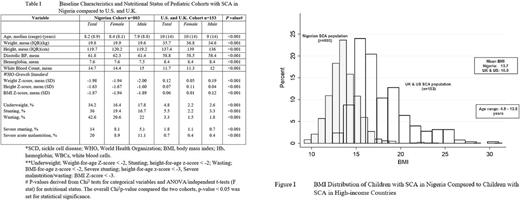Abstract
Introduction:
Two of the most common and life-threatening non-communicable diseases (NCD) among children in Nigeria are malnutrition and sickle cell anemia (SCA). SCA is one of the most common monogenic disorders, with an annual 305,000 births worldwide, 150,000 births in Nigeria, as compared to 1,700 births in the United States. Severe acute malnutrition is a previously unrecognized epidemic in children with SCA living in Sub-Saharan Africa, the impact of which usually falls on children under the age of five. Previous studies have reported poor growth and delayed maturation in children with SCA when compared to children without SCA, due to increased resting metabolic rate (proposed mechanism includes; decreased intake, hypermetabolism, increased hemolysis, red cell turnover and cardiac demand) and poor nutritional intake. The World Health Organization (WHO), UNICEF and World Bank have not established standards of care for children with severe acute malnutrition above 5 years of age. Additionally, these organizations have not acknowledged that children with SCA could be at risk for severe acute malnutrition. A recent study in Nigeria conducted in children with SCA, using the WHO-growth standards, demonstrated a high prevalence of wasting and severe wasting, as well as, stunting and severe stunting, 22.7% and 11.6%, respectively. However, WHO expected normal ranges for height and weight describes the growth of healthy children, not children with SCA. In a multi-institution cross-sectional study, we tested the hypothesis that severe acute malnutrition is more prevalent in older children (5 to 12 years old) with SCA in Nigeria when compared to an age-matched multi-institutional pediatric cohort of SCA from high-income countries.
Methods:
The study population in Nigeria included children with SCA between 5 to 12 years old, who were being screened for eligibility for National Institute of Health (NIH)-funded randomized controlled trial; the Primary Prevention of Stroke in Children with SCD in Sub-Saharan Africa (SPRING trial), from July 2016 to July 2017. The study population in the high-income countries (the U.S. and U.K), the comparison group, included children enrolled in the Sickle Cell Anemia Sleep and Asthma Cohort (SAC). Height, weight, age and sex were used to calculate body mass index (BMI). Anthropometric indices included weight-for-age and height-for-age, BMI-for-age, and were expressed as Z-scores to assess the nutritional status. The following definitions were used; underweight; weight-for-age Z-score below −2, stunting; height-for-age Z-score below −2, wasting; weight-for-height or BMI-for-age Z-score below −2. Severe acute malnutrition was defined as a very low BMI Z-score of below -3. These values were set from the median values of the WHO international growth reference.
Result:
A total of 803 in the Nigerian cohort and 153 children in the high-income countries cohort with SCA were included in the study. The median age in the Nigerian and in the high-income countries cohort was 8.2 and 10 years (range 4.9-13.8), respectively, and half were male (49.6 and 51.3%). The mean BMI in the Nigerian cohort was significantly lower when compared to high-income countries (13.7 versus 16.9 kg/m2 (p<0.001) [Figure I].
Of the 803 children in the Nigerian cohort, 34.2% were underweight, 36% had height-for-age below 2, and 42.6% had BMI-for-age Z-score below −2. A total of 20% in the Nigerian cohort met the criteria of severe acute malnutrition compared to 0.7% in the cohort in high-income countries (p <0.001) [Baseline characteristics and Nutritional Status are summarized in Table I].
Conclusion:
We demonstrate a significant unrecognized challenge of severe acute malnutrition among older children with SCA living in Nigeria, when compared to children with SCA living in high-income countries. Severe acute malnutrition is a devastating co-morbidity in children with SCA in northern Nigeria and perhaps in other regions of Africa. Future studies are needed to elucidate the public health impact, morbidity and mortality of severe acute malnutrition in this population. Currently no formal evidence-based strategies are available to treat severe acute malnutrition in children with SCA, but are greatly needed to decrease morbidity and even potentially mortality.
Rodeghier: Rodeghier consultants: Consultancy.
Author notes
Asterisk with author names denotes non-ASH members.


This feature is available to Subscribers Only
Sign In or Create an Account Close Modal